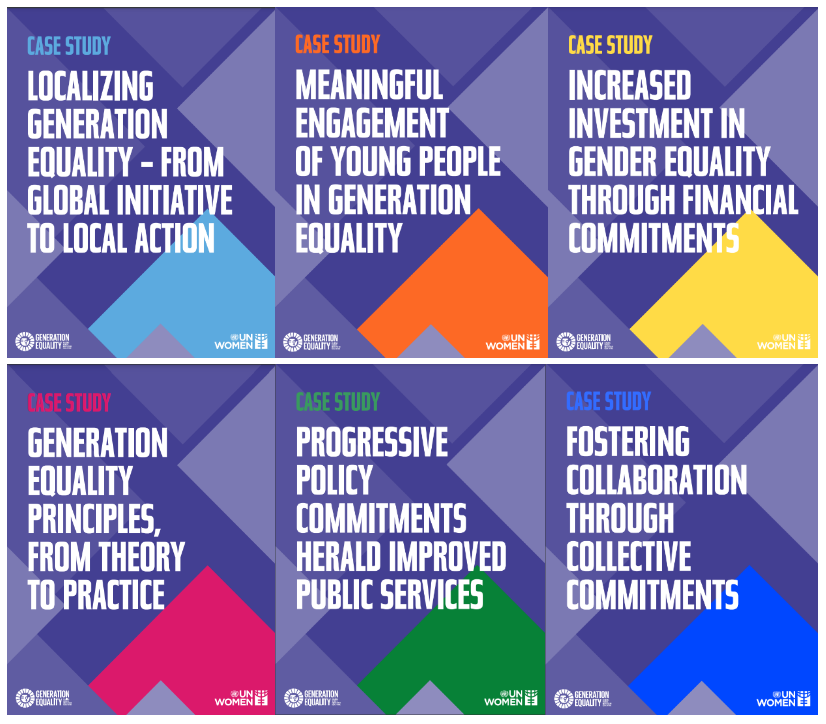“The Accountability Report is a tool by which Generation Equality’s stakeholders are enthusiastically held to account for the commitments they have made.” UN Women Executive Director, Sima Bahous.
At the Midpoint of the five-year Generation Equality initiative, the 2023 Accountability Report highlighted evidence and data on what has been achieved so far. The Report showed that Generation Equality is gaining momentum, and providing a common platform to address the key gender equality issues of our time.
And now, with the launch of six in-depth, analytical Case Studies that examine the experiences of beneficiaries and partners – we have a fuller picture of how the bold actions taken together under the Generation Equality umbrella are delivering concrete results for women and girls.
These six new Case Studies cover:
- Localizing Generation Equality
- Aspirations and engagement of young people in Generation Equality
- The composition and impact of financial commitments
- Adherence to Generation Equality core principles
- The nature and impact of policy commitments
- The nature and impact of collective commitments.

Transparency and accountability matter. As a complement to the quantitative survey data in the Accountability Report, these Case Studies investigate the qualitative shifts achieved through the implementation of Generation Equality commitments. Some key areas of identified impact, as well as common challenges, include:
- Localization breaks down silos – in Burkina Faso, Kazakhstan, Kenya and the United Republic of Tanzania, inter-ministerial steering committees have improved coordination between all stakeholders, resulting in an increased sense of ownership of Generation Equality commitments by governments, CSOs, young people and the private sector, and stronger collective action.
- Generation Equality is spurring new financial commitments – The 2022 data indicates that most reported financial commitments (64%) involved new or scaled-up funding. In the case of Finnfund, Generation Equality provided the momentum to emphasize the intersection of digital infrastructure and gender; similarly, Gucci’s flexible funding for youth-led movements were new or accelerated commitments made within the Generation Equality framework.
- Coordination and alignment between governmental bodies is fundamental for advancing a cross-cutting gender policy agenda – as identified by the Governments of Argentina, Kenya and Sweden, the process of formulating policy commitments under Generation Equality has improved coordination among government agencies, while also raising public awareness.
- Collective commitments are harnessing expertise and inspiring complementary initiatives – established organizational structures have enabled these collective commitments to gather expertise on specific issues, resulting in ‘experts in the field’ recognition, as has been the case for addressing financing gaps on gender-based violence prevention through the Accelerator.
- The importance of measuring adherence to Generation Equality core principles is acknowledged, but not yet standardized – ‘transformation’ is the shared definition that remains the most difficult to describe and reflect in impact monitoring.
- Young people’s meaningful engagement is key to transformation, but there are obstacles – young leaders reported that they are yet to fully realize this foundational aspiration of Generation Equality, and more progress is needed to move from ‘a seat at the table’ to true co-leadership and co-creation.
The key insights and lessons provided by these Case Studies will be taken forward in 2024 through a series of stakeholder dialogues – with each dialogue focusing on a related topic area, sharing best practices, and ensuring that improvements and recommendations can be taken forward across the commitment-maker network.
There is still a long way to go, but Generation Equality has made significant strides in advancing gender equality and driving progress towards the SDGs. Hearing directly from partners and beneficiaries through the Case Study process affirms the model is working, and offers valuable guidance for all commitments to ensure that promises are kept.
